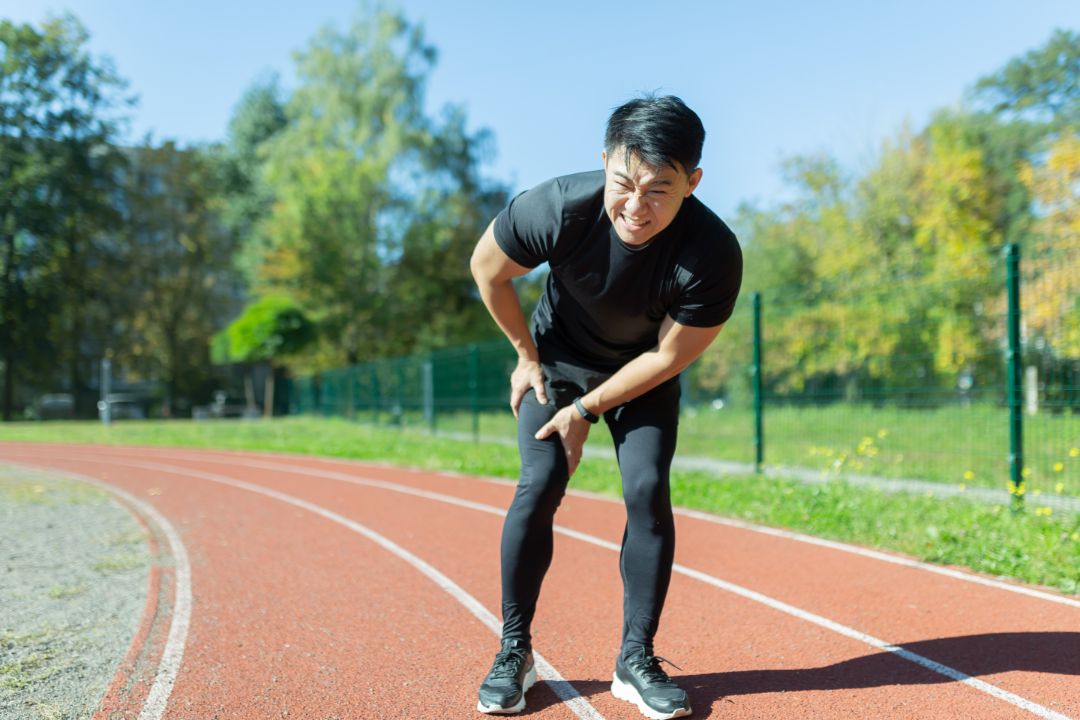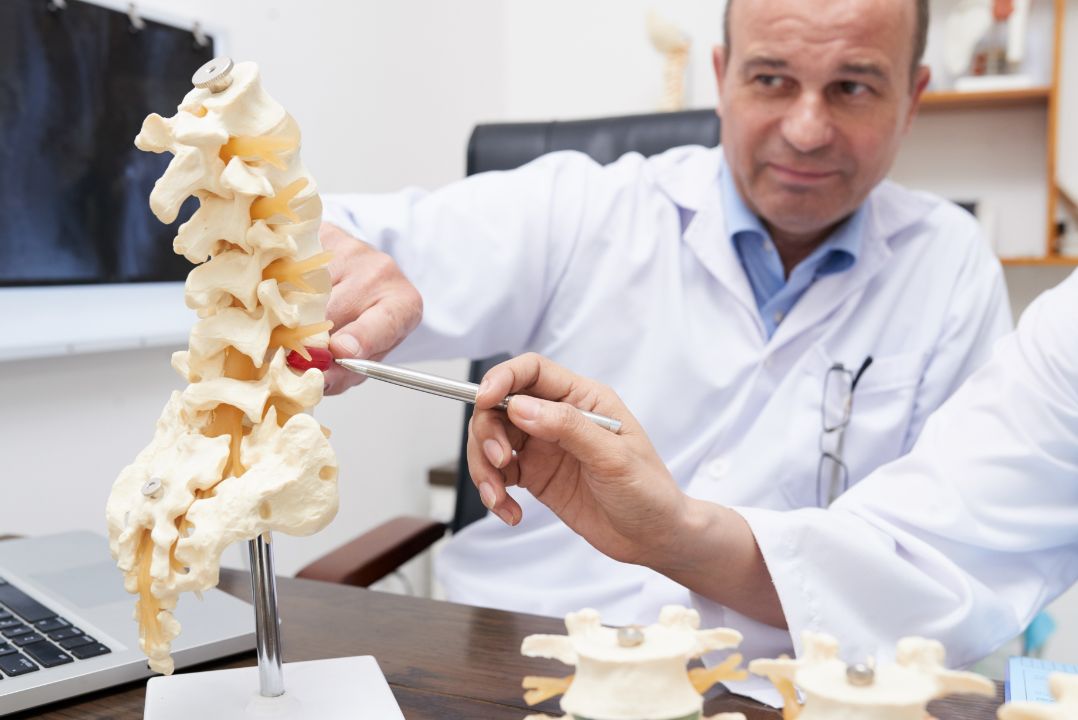Delayed onset muscle soreness (DOMS) can be a frustrating and painful experience, particularly for those who engage in regular physical activity. While soreness is a natural part of muscle growth and repair, excessive discomfort can hinder daily activities and even discourage further exercise.
Delayed onset muscle soreness (DOMS) is a common condition that causes muscle pain and tenderness. It usually occurs after engaging in high-intensity or unaccustomed exercise and typically peaks 24 to 72 hours after the workout.
DOMS is a result of microscopic damage to muscle fibres, which triggers an inflammatory response and causes muscle soreness. Muscle damage is often caused by eccentric contractions – when the muscle lengthens while under tension – which are common in activities such as downhill running or weightlifting. The damaged muscle fibres release inflammatory mediators, which attract immune cells to the affected site and trigger the characteristic swelling and pain associated with DOMS.
Besides eccentric contractions, several other factors contribute to DOMS, including:
DOMS is a natural response to muscle damage, and can be a sign that the muscle is adapting and becoming stronger. However, it can also hinder exercise performance and daily activities. Understanding the causes of DOMS is the first step in finding effective relief and prevention strategies.
Experiencing muscle soreness or DOMS can be unpleasant and uncomfortable. Fortunately, there are many effective methods for managing and alleviating DOMS-related pain.
Resting the affected muscles is one of the most effective ways to alleviate this condition. Avoiding activities that aggravate the pain, reducing physical activity or taking time off from training can help promote healing. A good night’s sleep can also help reduce muscle soreness.
The RICE method is a popular pain relief technique that can help reduce inflammation, swelling, and pain associated with DOMS. Applying ice to the affected area for 20 minutes at a time, several times a day, can help alleviate muscle soreness. Compression and elevation of the affected limb can also aid in reducing inflammation.
Stretching and foam rolling effectively reduce muscle tension and tightness, which can contribute to DOMS. Gentle stretching exercises like yoga can help improve flexibility and reduce the soreness. Foam rolling can massage the muscles, improve blood flow and reduce muscle soreness.
Over-the-counter medications such as ibuprofen or acetaminophen can be useful for managing muscle soreness. However, it is important to avoid prolonged use of these medications and to follow the recommended dosage.
Massage can also be an effective method for managing DOMS-related pain. Massage can help reduce muscle tension, increase blood flow to affected muscles and promote relaxation. However, excessive pressure can cause further damage, so it is important to seek the advice of a qualified massage therapist.

Photo Credit: Iakobchuk, Envato
After experiencing delayed onset muscle soreness, it is essential to help your muscles recover as quickly as possible. Fortunately, you can use various techniques and strategies to speed up muscle recovery.
Active recovery exercises are low-intensity activities that help increase blood flow and promote healing. They can include activities such as walking, cycling, or light swimming. By doing these activities, you can keep your muscles moving and help reduce muscle soreness and stiffness.
What you eat can help your muscles recover faster. Consuming protein-rich foods such as lean meats, eggs, and dairy can provide the necessary nutrients to repair and rebuild damaged muscle tissue. Additionally, consuming complex carbohydrates can help replenish glycogen stores, which can be depleted during exercise.
Drinking plenty of water is crucial for muscle recovery. Water helps transport nutrients to your muscles and can aid in removing waste products. If you’re dehydrated, your muscles can become more prone to injury and soreness.
Getting enough sleep is essential for muscle recovery. When you sleep, your body releases growth hormone, which helps repair and rebuild muscle tissue. Aim to get at least 7-8 hours of sleep per night to help support muscle recovery.
Massage can help improve blood flow and reduce muscle tension, aiding muscle recovery. You can use a foam roller or massage ball to target specific muscles or get a professional massage for a more comprehensive treatment.

Photo Credit: voronaman111, Envato
Delayed onset muscle soreness can be prevented by taking several measures focusing on gradual exercise progression and proper warm-up and cool-down routines. Here are some tips for preventing DOMS:
Following these tips can reduce the likelihood of experiencing DOMS and enjoy the benefits of a healthy, active lifestyle.
Delayed onset muscle soreness (DOMS) is often associated with inflammation in the affected muscles. When muscles are subjected to excessive load, particularly in unaccustomed exercise, microscopic muscle damage occurs at the cellular level. This damage triggers an inflammatory response that leads to muscle soreness and stiffness.
Inflammation is the body’s natural response to injury or infection. During inflammation, white blood cells and immune cells are sent to the affected area to begin the healing process. These cells release chemical substances that help clean up cellular debris and promote new tissue growth. However, these substances can also cause pain and inflammation.

Photo Credit: DragonImages, Envato
Although inflammation is a necessary part of the healing process, excessive inflammation can prolong DOMS symptoms and delay recovery. Fortunately, there are several ways to manage inflammation and minimize its impact on muscle soreness:
By managing inflammation effectively, you can minimise the impact of delayed onset muscle soreness on your daily activities and speed up your recovery time.
Delayed onset muscle soreness (DOMS) can make it difficult to perform daily activities, but some lifestyle habits can help reduce its impact.
Stress can increase muscle tension and exacerbate DOMS. Practicing stress-management techniques like meditation, yoga, or deep breathing can reduce tension and promote relaxation, helping to alleviate muscle soreness.
Poor posture or ergonomics can cause muscle tension, which can exacerbate DOMS. Sit and stand with the correct posture, and invest in ergonomic office furniture if necessary.
Heat can help to improve blood flow, reduce muscle tension, and alleviate DOMS. Applying a warm compress or taking a warm bath can be helpful in managing muscle soreness.
DOMS can be a source of discomfort and inconvenience, but fortunately, there are many effective strategies for managing and preventing it. By understanding the causes of muscle soreness and inflammation, you can take proactive steps to minimise their impact and speed up recovery. Here are some final tips for managing DOMS:
One of the most important things you can do to prevent DOMS is to listen to your body. Be mindful of your limits, and don’t push yourself too hard too quickly. Gradual progression will help your muscles adapt and minimize the risk of soreness or injury. If you do experience DOMS, take the time to rest and recover before resuming your workouts.
Proper hydration is essential for muscle recovery and reducing inflammation. Ensure you drink plenty of water before, during, and after your workouts. You can also incorporate sports drinks or coconut water to replenish electrolytes lost during exercise.
A balanced diet rich in protein, carbohydrates, and healthy fats will give your muscles the fuel they need to repair and grow. Consider incorporating anti-inflammatory foods like fatty fish, leafy greens, and berries into your meals to minimize inflammation.
Active recovery exercises, such as walking or gentle stretching, can help increase blood flow to your muscles and promote healing. Light mobility work or foam rolling can also help speed up recovery and reduce muscle soreness.
Heat therapy, such as using a heating pad or taking a warm bath, can help increase blood flow and reduce muscle pain. Just be careful not to use heat on an acute injury or inflammation.

Photo Credit: Iakobchuk, Envato
DOMS may be an inevitable part of a challenging workout routine, but by managing and preventing it, you can minimise its impact on your daily life. Incorporate these tips into your fitness regimen, and you’ll be on your way to better muscle recovery and a more pain-free existence.
DOMS stands for delayed onset muscle soreness. It refers to the muscular pain and discomfort typically experienced 24 to 72 hours after exercise.
DOMS is caused by microscopic damage to muscle fibres during strenuous exercise or unfamiliar activities. This damage triggers an inflammatory response, leading to muscle pain and inflammation.
Effective relief strategies for managing DOMS-related pain include rest, ice, compression, elevation (RICE), stretching, and foam rolling. These techniques can help reduce inflammation and promote muscle recovery.
It is important to ensure proper nutrition, hydration, and sleep to aid muscle repair and recovery. Active recovery exercises and massage can also help stimulate blood flow and accelerate the healing process.
To minimise the occurrence of DOMS, it is recommended to gradually progress in exercise, warm up and cool down properly, and incorporate strength training into your routine. These measures can help prepare your muscles for intense activity and reduce the risk of muscle soreness.
Inflammation is a natural healing response to muscle damage and plays a significant role in DOMS. Managing inflammation through nutrition and supplementation can help alleviate muscle soreness and promote faster recovery.
To reduce the impact of DOMS on daily activities, it is beneficial to prioritize stress management, maintain proper ergonomics, and consider using heat therapy to alleviate muscle pain and discomfort.
In conclusion, remember to listen to your body, gradually increase exercise intensity, and give yourself time to recover. Applying these tips and the strategies discussed can help effectively manage DOMS and minimise muscle soreness.